July 18, 2019 feature
Bioinspired MXene-based actuators for programmable smart devices
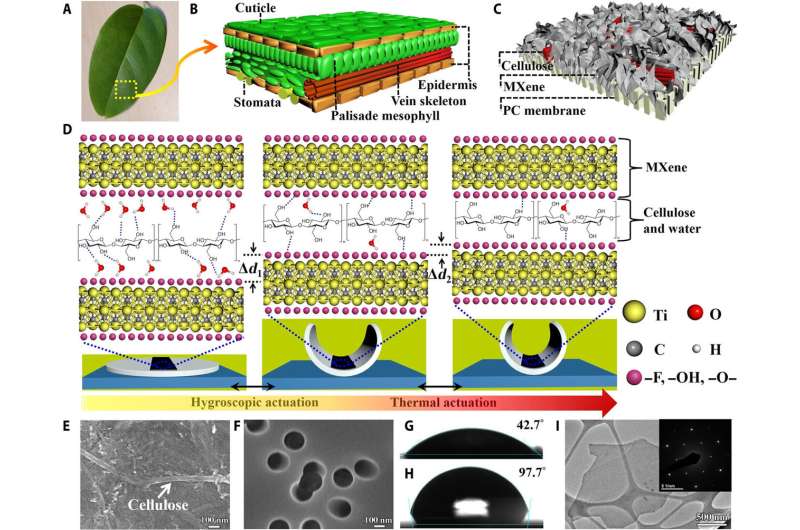
During photosynthesis, natural leaves with elaborate architectures and functional components can harvest and convert solar energy into chemical fuels that are converted into energy. The biological energy production has provided materials scientists a new bioinspired paradigm to produce many autonomous systems, including light-triggered motion. In a recent report, Guofo Cai and co-workers at the departments of Materials Science and Engineering, Astronautic Science and Mechanics, and Chemical Engineering, developed an unprecedented bilayered actuator base on MXene (Ti3C2Tx)-cellulose composites (MXCC) and polycarbonate (PC) membranes.
The device mimicked the sophisticated architecture of a leaf and showed energy-harvesting and conversion capabilities similar to photosynthesis. The bilayered actuator contained highly desirable features including; multi-responsiveness, low-power actuation, fast actuation speed, large-shape deformation, robust stability and programmable adaptability—well suited for modern soft actuator-based smart systems. Cai et al. believe these adaptive soft systems will be attractive as revolutionary technologies to build soft robots, smart switches, for information encryption, infrared dynamic display, camouflage and temperature regulation. They envision additional uses of the technology to develop human-machine interfaces such as haptics. The study is now published in Science Advances.
Materials scientists have studied materials and devices that dynamically change shape, size and electrical/mechanical properties in response to external stimuli for a variety of applications. Such devices have important functions as actuators, artificial muscles, in robotics, as energy generators, sensors and smart curtains. Scientists have devoted substantial efforts to develop smart actuators based on a variety of active materials such as carbon nanotubes and graphene, shape memory polymers, gels, conjugated polymers and liquid crystal elastomers as well as ceramics and alloys.
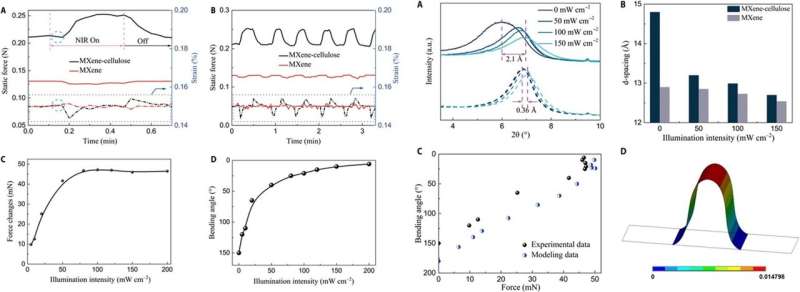
A variety of environmental stimuli such as humidity, temperature, electricity, light and pH can trigger physical alterations of these materials. But it is presently difficult to enhance the speed of actuation and scale-up shape changes due to poor mechanical and thermal instability that restrict their capabilities. Building a smart actuator that responds to diverse stimuli such as humidity, electricity, heat or light with fast actuation, large-shape deformation, programmable adaptability and robust stability is therefore highly desirable. To build new and improved material properties, the materials scientists must therefore explore previously unidentified combinatorial materials and rationally design device configurations to invent high-performance actuators.
MXene (Ti3C2Tx) used in the present work belongs to a new family of liquid-crystalline, two-dimensional (2-D) metal carbides with excellent electrical conductivity, thermal conductivity and photothermal conversion to form multiresponsive and potentially high performance actuators. Only a single example currently exists of the use of MXene as an electrochemical actuator. In the present work, therefore, Cai et al. aimed at using MXene as a multiresponsive soft actuator to explore leaf-inspired, sophisticated architecture for simple actuation, coupled with synergistic functional components.
Inspired by the biological architecture and photosynthetic mechanism of a natural leaf, Cai et al. designed an asymmetric, bilayered soft actuator using single-crystal, 2-D MXene nanosheets to harvest electric or light energy for conversion into thermal energy. For this, they used biocompatible, cellulose nanofibers to form the vein skeleton for rapid leaf-like shape changes alongside polycarbonate (PC) filter membranes to form the stomata and epidermis for water insertion and extraction to or from the MXene-cellulose composites (MXCC). The scientists confirmed the increased absorption of water in MXCC due to the presence of cellulose using Fourier Transform Infrared (FTIR) spectra. Using selected area electron diffraction (SAED) patterns, they detected the presence of MXene as a hexagonal structure and single crystallinity without defects at the nanometer scale.
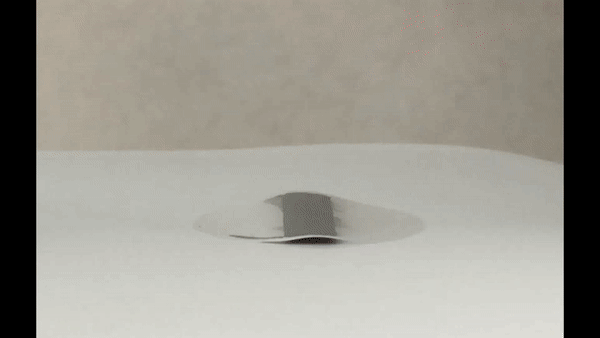
The soft actuator maintained a flat and unwrinkled form under ambient conditions with relative humidity, while bending in response to increasing/decreasing humidity in the environment, which Cai et al. quantitatively analyzed. They noted excellent actuator performance and controllable bending angles in a variety of humidity levels. The scientists next investigated the electrical actuation of the device by connecting an MXene-cellulose strip to two copper wires. The bending angle almost linearly decreased with increasing electrical power, while the soft actuator only required a low voltage to achieve extreme actuation. Compared to humidity-based actuation, the scientists achieved larger bending angles with electrothermal actuation.
The scientists also recorded temperature variation and binding angles of soft actuators using near infrared (NIR) light irradiation. They observed remarkable synergistic actuation motion of the MXene/cellulose composite material, in contrast to poor actuation performance of the individual components. Based on the observed optical absorption, photothermal conversion and electrochemical actuation, Cai et al anticipate the use of these composite smart soft actuators in photo-responsive functions.
Cai et al. further investigated the photoinduced mechanical forces of the material under NIR light irradiation on a mechanical analyzer. The actuation process of MXCC/PC was rapid and reversible. The scientists studied the structural changes of the MXCC/PC and MXene/PC actuators under different intensities of illumination using X-ray diffraction (XRD) measurements to show amorphous character of cellulose and PC membrane. They investigated the mechanical behavior using finite element modelling methods (FEM) to further understand the actuation process of the composite material. The modeling results agreed with the experimental outcomes in the study.
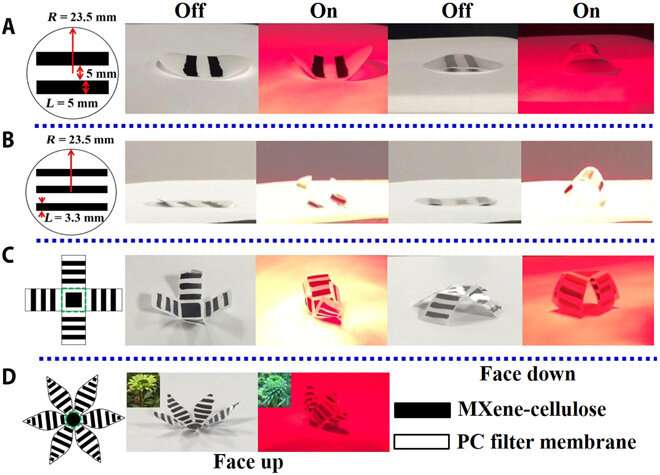
To demonstrate programmable actuation behavior, the scientists developed a series of sophisticated configurations. Including a double folding U-shaped actuator, trefoil arch-shaped actuator and self-blooming flower where the petals opened and bloomed before NIR irradiation to close rapidly on exposure to NIR. Additionally, the scientists explored a variety of smart devices such as worm-like robots, smart switches, an encryption device as well as IR dynamic display and camouflage to extend the primary concept. Furthermore, Cai et al. constructed a smart switch by patterning cross-shaped MXCC on the PC membrane, which they controlled using wireless NIR light. Based on the principles, the scientists also formed an open electrical circuit to switch on/off a smart watch using NIR light.
For data encryption, based on the programmable MXene-cellulose ink, Cai et al. engineered a desired pattern and conveyed the information by local heating using NIR light or electricity. The information was only readable using IR and invisible to the human eye, providing better suited information encryption beyond machine readable barcodes and QR codes. The ability to integrate diverse functionalities into one system to achieve camouflage, display and actuation is important and useful in multiple disciplines. These devices confirmed the possibility of using MXCC/PC membranes to serve multiple functions in smart soft systems including information encryption, camouflage and thermo-responsive behavior.
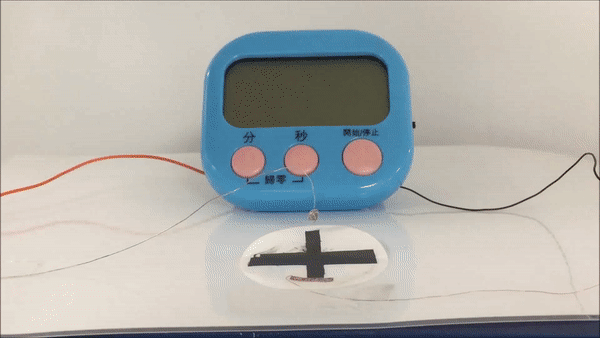
The new composite materials, rational design and low-cost fabrication introduced in the study, alongside synthetic strategies implemented by the scientists, will make the MXCC/PC membrane systems accessible for broad scientific and engineering fields. In this way, Guofa Cai and co-workers developed and established a new class of multiresponsive materials and devices with unprecedented integration of multiple properties inspired by multifunctional biological structures.
The MXCC/PC membrane systems mimicked crucial features of a natural leaf from the microstructure to photosynthetic capabilities, which included energy-harvesting and conversion. The bilayer actuators showed strong features, similar to state-of-the-art multiresponsive actuators. The explored materials and advanced systems can be further developed to establish novel possibilities for revolutionary technologies in the fields of soft robotics, information encryption and IR dynamic display.
More information: Guofa Cai et al. Leaf-inspired multiresponsive MXene-based actuator for programmable smart devices, Science Advances (2019). DOI: 10.1126/sciadv.aaw7956
M. Ma et al. Bio-Inspired Polymer Composite Actuator and Generator Driven by Water Gradients, Science (2013). DOI: 10.1126/science.1230262
Xili Lu et al. Liquid-Crystalline Dynamic Networks Doped with Gold Nanorods Showing Enhanced Photocontrol of Actuation, Advanced Materials (2018). DOI: 10.1002/adma.201706597
R. H. Baughman. MATERIALS SCIENCE: Playing Nature's Game with Artificial Muscles, Science (2005). DOI: 10.1126/science.1099010
Journal information: Science Advances , Science , Advanced Materials
© 2019 Science X Network




















